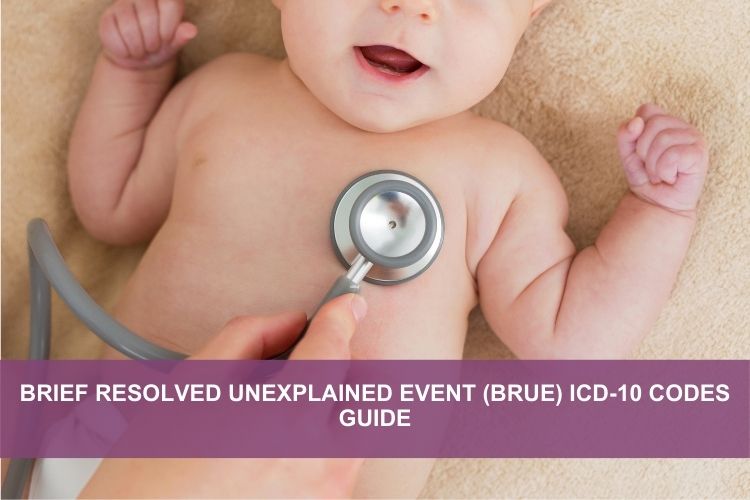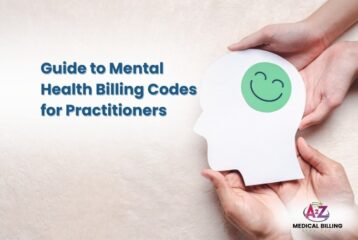Brief Resolved Unexplained Event (BRUE) in infants is a crucial responsibility for healthcare providers due to its short and uncertain experience. This condition is mostly cleared as an Apparent Life-Threatening Event (ALTE). Understanding the correct ICD 10 code for BRUE is critical for accurate documentation. Proper coding enables correct billing and facilitates effective patient care.
Healthcare providers often struggle in BRUE coding cases because of the various symptoms and the need for detailed documentation. The ICD-10 code R68.13 plays a key role in accurately recording a BRUE, but additional codes may be required to capture any related symptoms or underlying conditions.
Through this guide, the key ICD-10 codes related to BRUE provide you with the information needed to document these cases accurately and comprehensively.
Understanding BRUE and Its Importance
Brief Resolved Unexplained Events (BRUE) are sudden, alarming episodes in infants that can worry both parents and healthcare providers. Proper identification and documentation of these events are vital for accurate diagnosis, effective care, and precise coding.
What is BRUE
BRUE, previously known as Apparent Life-Threatening Event (ALTE), refers to sudden, unexpected episodes in infants characterized by changes in breathing, skin color, muscle tone, or alertness. These events often resolve rapidly without an identifiable cause, presenting challenges in diagnosis and management.
Why Recognizing BRUE Matters
Recognizing BRUE is crucial because, despite the episode often resolving its own, it may signal an underlying medical condition that requires attention. Early detection and precise documentation are essential for proper monitoring, follow-up care, and better patient outcomes.
ICD 10 Codes Related to BRUE
When dealing with a Brief Resolved Unexplained Event (BRUE), it’s essential to select ICD-10 codes that correctly capture the condition and related symptoms. Accurate coding facilitates effective documentation, treatment, billing, and analysis of these episodes.
The Primary Code: R68.13
R68.13 is the primary ICD-10 code for documenting a BRUE, an event in an infant that resolves without a clear cause. Healthcare providers must use this code to accurately report sudden, unexplained nature episodes, ensuring proper follow-up care.
Additional Codes Related to BRUE
In some cases, additional ICD-10 codes are needed for a smooth clinical picture of a BRUE episode. For example:
| ICD-10 Code | Description | Relevance to BRUE |
| R90.2 | Sudden unexplained death in infancy (SUDI) | It is crucial if BRUE is viewed as a factor contributing to SUDI. |
| R90.3 | Sudden unexplained death in childhood (SUDC) | Applicable if BRUE is associated with unexplained deaths in children. |
| R65.2 | Apnea | Applicable when apnea episodes are part of a BRUE event. |
| R65.3 | Apnea of infancy | Specifically used for infants experiencing apnea during a BRUE event. |
| R90.1 | Apparent life-threatening event (ALTE) | Used when a severe event similar to BRUE is documented. |
| G81.3 | Epilepsy | Considered when seizures or epilepsy are suspected or confirmed. |
| G93.8 | Other disorders of the autonomic nervous system | Pertinent, when issues with the autonomic nervous system are detected. |
| Q07.0 | Congenital heart disease | Used when congenital heart disease is suspected with BRUE. |
| J96.0 | Acute respiratory failure | Relevant, if significant respiratory distress occurs during a BRUE. |
| N17.- | Acute kidney failure | Important, if acute kidney dysfunction is observed during a BRUE. |
| G93.41 | Metabolic encephalopathy | Considered, when metabolic issues are suspected as a cause. |
| D65 | Disseminated intravascular coagulation (DIC) | Relevant, when DIC is diagnosed in connection with a BRUE event. |
| K72.0- | Acute hepatic failure | Used when liver dysfunction or failure is linked to a BRUE. |
The Link Between BRUE, SUDI, and SUDC
Understanding the connection between Brief Resolved Unexplained Events (BRUE) and conditions like Sudden Unexpected Death in Infancy (SUDI) and Sudden Unexplained Death in Childhood (SUDC) is important for healthcare professionals. Although BRUE episodes usually resolve without severe outcomes, they can sometimes signal a higher risk for these more serious and tragic conditions.
Understanding SUDI and SUDC
Sudden Unexpected Death in Infancy (SUDI) and Sudden Unexplained Death in Childhood (SUDC) refer to examples where a child dies unexpectedly and without a clear cause, often during sleep. Understanding these conditions is essential for healthcare providers, as recognizing them can help check out and manage the risks associated with previous BRUE incidents.
Relevant ICD-10 Codes for SUDI and SUDC
For cases related to SUDI and SUDC, specific ICD-10 codes are used:
- R90.2: Sudden unexplained death in infancy (SUDI) – This code is used when an infant under one year of age dies suddenly with no identifiable medical cause, often following a BRUE episode. It aids in tracking and studying these cases.
- R90.3: Sudden unexplained death in childhood (SUDC) – Applied to cases where a child over one year dies unexpectedly without a known cause, this code is crucial for documenting and understanding any possible links to earlier BRUE events.
Essential Coding Tips for BRUE for Healthcare Administrators
Accurate coding of Brief Resolved Unexplained Event (BRUE) cases is essential for maintaining precise medical records, ensuring quality patient care, and securing appropriate reimbursements.
Common Coding Challenges
Coding BRUE cases often involves several difficulties, such as:
- Differentiating between primary and secondary codes.
- Choose the correct ICD-10 codes based on clinical documentation.
- Avoid billing mistakes due to incorrect code application.
- Ensure comprehensive documentation of patient outcomes.
Best Practices for Documentation
To overcome coding challenges, it’s important to focus on thorough documentation. Best practices include:
- Accurate recording of all relevant symptoms and clinical findings in the patient’s record.
- Document any pre-existing conditions that could impact the BRUE diagnosis.
- Provide detailed descriptions of the circumstances surrounding the BRUE event.
- Keep note of all related conditions and any subsequent actions taken.
Conclusion
Accurate documentation, billing, and patient care in BRUE for infants need an understanding of the relevant ICD-10 codes. R68.13 is used for BRUE documentation. To ensure a complete and precise record add more codes for related conditions. Understanding the link between BRUE, SUDI, and SUDC is critical for assessing risks and providing proper care. Best practices in coding and documentation are essential for better patient care and maintaining accurate medical records.
FAQs
What is a Brief Resolved Unexplained Event (BRUE)?
A BRUE is a sudden, short-lived, unexplained episode in infants, often involving changes in color, breathing, or muscle tone, with no identifiable medical cause.
Which ICD-10 code is assigned to BRUE?
The primary ICD-10 code for documenting BRUE is R68.13, used to classify brief resolved unexplained events in infants.
Why is precise coding crucial for BRUE cases?
Precise coding is vital for accurate documentation, proper billing, and effective patient care, ensuring that providers avoid errors and stay compliant.
What are the common challenges in coding BRUE?
Challenges include choosing the correct codes, distinguishing between primary and secondary conditions, and ensuring thorough documentation.
How can healthcare providers improve BRUE documentation?
Providers can improve documentation by clearly recording symptoms, noting any pre-existing conditions, and thoroughly describing the BRUE event.



